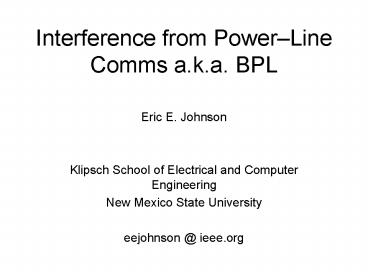Interference from PowerLine Comms a'k'a' BPL PowerPoint PPT Presentation
1 / 26
Title: Interference from PowerLine Comms a'k'a' BPL
1
Interference from PowerLine Comms a.k.a. BPL
- Eric E. Johnson
- Klipsch School of Electrical and Computer
Engineering - New Mexico State University
- eejohnson _at_ ieee.org
2
Threats to HF Spectrum
Demands by Other Users
Our Spectrum Allocations
Noise Floor
BPL Interference
3
Access BPL Concept
NTIA BPL Report 04-413 Volume I, Figure 2-2
4
Threat from BPL/PLC
- BPL (a.k.a. PLC) operates throughout the HF band
(1.7 80 MHz) - Unlike coax or twisted pair, power lines radiate
profusely - Field trials in many nations have confirmed the
interference potential
5
German NB30 Radiation Limits
- Frequency dependent limits
- At 1 MHz 40 dB (µV/m) in 9 kHz at 3 m
- Considered too high by radio usersConsidered too
restrictive by PLC industry
6
Field Trials in Arnhem, NL
- PLC installed at 3 transformer stations in 01
noise measured before/after - Receivers in affected areas required 25 dB more
power for same SINAD as before - Model predicts 34 dB(µV/m) at 1 km radius from
town with 4 PLC nets per km2 - Terminated in 03 as economically unfeasible
7
EC PLC Workshop (Oct 2003)
- Austria proposes 14 dB(µV/m) _at_ 10 mprobably
40 dB better than industry can meet - Finland industry proposal of 55 dB(µV/m) is 40
dB too high - Switzerland (Fribourg trials results) PLC
exceeds NB30 limit by up to 24 dB. HF SNRs
reduced by up to 14 dB.
8
US FCC Proposed Rulemaking
- Current Part 15 Rules 1.70530 MHz (freq
independent) 30 µV/m _at_ 30 m - (much higher than NB30)
- April 03 FCC requested comments on
deployment of BPL within this limit
9
Objections Raised
- Amateur radio community 53 of survey
respondents have antennas within 30m of an
outdoor power line - NTIA interference to Federal HF users
- FEMA interference to emergency comms
- NAS interference to radio astronomy
- (numerous additional objections)
10
FCC Proposed Rulemaking
- Impressed by potential benefits of BPL
- Not impressed by unsupported claims of
interference - Proposed rules (04-29, dated 23 Feb 04)
- Existing limits will apply
- National registry of BPL systems
- Adaptive interference mitigation required
- New measurement guidelines
11
NTIA Review
- NTIA is US Presidents principal adviser on
domestic and international telecomms policy - Manages Federal use of spectrum
- Recently studied potential BPL interference
- Despite study results, supports Part 15 limits
12
NTIA Phase I Study
- Evaluated interference range using NEC for BPL
devices conforming to Part 15 rules
13
NTIA Phase I Study
- Appendix B notes numerous case studies
- Austria massive disruption of Red Cross
exercise (May 2003) by PLC - Japan Access PLC found to jam HF comms
- Excessive radiated noise levels reported in
measurements from Germany, Netherlands, Norway,
Switzerland
14
Air Force Comments
- Do not support NTIA position that current Part 15
emission levels are sufficient - Emphasizes HF Comms vital to military
- SCOPE Command
- Allied interoperability
- Slight increase in noise floor may be disastrous
15
Air Force Comments
- Notes wide difference from Part 15 to NB30 and
proposed European standards - Suggests initial deployment
- No more than 1 year
- Emission limits no higher than Part 15
- Adjust up or down based on experience with these
limits and the interference mitigation techniques
16
Project OPERA
- Open PLC European Research Alliance
- 35 European institutes, universities, agencies
- Working toward new generation PLC
- Simple and standardized
- Higher performance (up to 200 Mbps)
- Addresses radio interference issues
17
New Aspect Homeland Security
- Use BPL for remote monitoring (cameras) of
critical infrastructure - Carried on high- and medium-voltage lines(noise
on HV lines may be too severe) - IP routers for line-fault robustness
- Expands direct BPL interference from residential
areas to nationwide problem
18
Action Required
- Support national authorities in seeking
acceptable limits on PLC/BPL emanations - Make high-quality measurements of PLC/BPL effects
in ongoing trials
19
Questions?
20
FCC Interference Mitigation
- Dynamic / remote power reduction
- Adjustment of operating frequencies
- Remote shutdown feature(for systems found to be
interfering)
21
FCC Measurement Guidelines
- All Access BPL devices to be measured in situ
- Magnetic loop antenna below 30 MHzElectric field
antenna above 30 MHz - Measure at fixed distance along power lineat
height of 1 meter (for loop antenna) - Extrapolation allowed (slant range)
22
NTIA Phase I Study
- Potential Interference From Broadband Over Power
Line (BPL) Systems To Federal Government
Radiocommunications at 1.7 80 MHz, NTIA
Report 04-413, April 2004 - Available for download www.ntia.doc.gov
23
NTIA Phase I Study
- High interference because current methods
underestimate peak power levels - NTIA recommends improved compliance measurement
procedures - Measure at height of power lines
- At uniform distance of 10 m from device/line
- Use calibrated measuring antenna
24
NTIA Phase I Study
- Measurement campaigns
- Horizontally polarized interference peaks near
BPL device (within 30 m) - Vertically polarized interference peaks under
line, at impedance discontinuities far from BPL
device
25
NTIA Phase I Study
- Did not address
- Aggregation of interference from multiple BPL
devices via ionospheric propagation - Out of band emissions and IM products
- Interference or damage to BPL devices from
current spectrum users - Will be addressed in Phase 2 of study
26
NTIA Aggregation Estimates
- Preliminary analysis of aggregated interference
due to ionospheric propagation - Harmful interference unlikely from a single
sizable metropolitan installation - Aggregate effect from a nationwide deployment
more significant - Some questions regarding methodology

